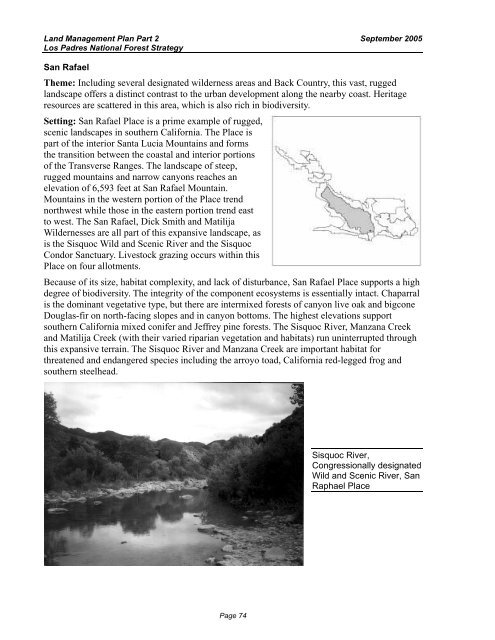Land Management Plan - Part 2 Los Padres National Forest Strategy
Land Management Plan - Part 2 Los Padres National Forest Strategy
Land Management Plan - Part 2 Los Padres National Forest Strategy
Create successful ePaper yourself
Turn your PDF publications into a flip-book with our unique Google optimized e-Paper software.
<strong>Land</strong> <strong>Management</strong> <strong>Plan</strong> <strong>Part</strong> 2<br />
<strong>Los</strong> <strong>Padres</strong> <strong>National</strong> <strong>Forest</strong> <strong>Strategy</strong><br />
September 2005<br />
San Rafael<br />
Theme: Including several designated wilderness areas and Back Country, this vast, rugged<br />
landscape offers a distinct contrast to the urban development<br />
along the nearby coast. Heritage<br />
resources are scattered in this area, which is also rich in biodiversity.<br />
Setting: San Rafael Place is a prime example of rugged,<br />
scenic landscapes in southern California. The Place is<br />
part of the interior Santa Lucia Mountains and forms<br />
the transition between the coastal and interior portions<br />
of the Transverse Ranges.<br />
The landscape of steep,<br />
rugged mountains and narrow canyons reaches an<br />
elevation of 6,593 feet at San Rafael Mountain.<br />
Mountains in the western portion of the Place trend<br />
northwest while those in the eastern portion trend east<br />
to west. The San Rafael, Dick Smith and Matilija<br />
Wildernesses are all part of this expansive landscape, as<br />
is the Sisquoc Wild and Scenic River and the Sisquoc<br />
Condor Sanctuary. Livestock grazing occurs within this<br />
Place on four allotments.<br />
Because of its size, habitat complexity, and lack of disturbance, San Rafael Place supports a high<br />
degree of biodiversity. The integrity of the component ecosystems is essentially intact. Chaparral<br />
is the dominant vegetative type, but there are intermixed forests of canyon live oak and bigcone<br />
Douglas-fir on north-facing slopes and in canyon bottoms. The highest elevations support<br />
southern California mixed conifer and Jeffrey pine forests. The Sisquoc River, Manzana Creek<br />
and Matilija Creek (with their varied riparian vegetation and habitats) run uninterrupted through<br />
this expansive terrain. The Sisquoc River and Manzana Creek are important habitat for<br />
threatened and endangered species including the arroyo toad, California red-legged frog and<br />
southern steelhead.<br />
Page 74<br />
Sisquoc River,<br />
Congressionally designated<br />
Wild and Scenic River, San<br />
Raphael Place
















